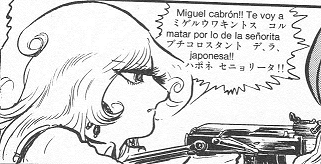El Calvados Part 3: Problemas Maritales en los Buques de la Nada
So we thought the crazy Spanish in Black Ships of Nothingness was over but we were wrong. Miguel follows Mio onto the ship headed for Japan, and all of the sudden his angry wife shows up again. And of course she starts talking. Forgive me but I can’t resist these linguistic games!! The amazing thing is if you read the katakana Japanese quickly it does sound kinda like Spanish!!!
First, Mrs. Albatrós points a machine gun to her hubby’s head and says:
1. ¡¡Miguel cabrón!! ¡¡Te voy a matar por lo de la señorita japonesa!!
LET: Miguel you fucker!! I’m going to kill you because of what you did with the Japanese lady!!
JK: Migeruuwakintosu, koru buchikorosutanto de, la, hapone senyoriita!!
Migeruuwakintosu – We already deciphered “uwakintosu” as “cheating (on me)” so this means “Miguel, you cheat!” The “koru” that follows reminds me of the interjection “kora” which Japanese use when they’re angry and want to be rough. “Buchikorosu” is a nasty way to say you will kill someone, and the “tanto” is there to sound Spanish (plus it is an actual Spanish word). “Hapone” is a good approximation of Spanish “japonés” (=”Japanese”) and the missing “s” is no problem because the next word, Spanish “señorita”, starts with an “s”. As you can see, then, this is quite close the original Spanish meaning.
Now, at this point the wife shoots Miguel, but she doesn’t have real bullets in her gun. So she starts chasing him around and before she goes off she turns to Mio, smiles, winks and says:
2. ¡¡Chao señorita!! Eres una buena mujer.
LET: Goodbye lady!! You’re a good woman.
JK: Chao senyoriita!! Yuubeppintosu Migerutamaranba.
chao senyoriita – Well, for once, the katakana does what it’s supposed to do, which is to render as faithfully as possible the sounds of the original. Spanish “chao”, BTW, is a loan from Italian “ciao” and where I come from it’s mostly used by women. Also, whereas Italian “ciao” can mean both “hello” and “goodbye”, Spanish “chao” always means “goodbye”.
yuubeppintosu – “yuu” is the English “you”, “beppin” in Japanese refers to a beautiful woman, a “babe”. The “tosu” we have seen before as a mock Spanish ending “-tos”. “tamaran” is a common variant of “tamaranai”, which we saw earlier meant “irresistible”, whereas “ba” seems to be a mock Spanish ending (maybe Leiji was trying to approximate the famous Spanish word “caramba”).
The whole thing comes out as: “Goodbye lady!! You’re a fine (=gorgeous) woman. Miguel couldn’t resist you”. This sort of shocking camaraderie is something Leiji indulges in throughout his stories.
The wife runs off and the last we hear from her is:
3. ¡¡Detente Miguel que te voy a matar!!
LET: Wait up Miguel, I’m going to kill you!!
JK: Machinetantosu nige Migeru dotekoroshimente!!
machinetantosu – One way to say “wait up” in Japanese is “machi-nasai”. Here we see a form of that (“machine”) plus the Spanish-sounding “tantosu” (there is a word “tantos” in Spanish too).
nige Migeru – “Nige” is the root of the verb “nigeru” (“to run away”), so “nige Migeru” might be some sort of (incorrect, but comprehensible) Japanese compound meaning “the escaping Miguel”.
dotekoroshimente – “koroshi” is a form of Japanese “to kill”. The “dote” and “mente” seem to be there for the Spanish-y sound. In fact, “-mente” is the Spanish suffix for adverbs (equivalent to “-ly” in English).
***
Later on Mio is on deck, she gets sick and vomits. Everyone thinks she’s pregnant from Miguel. Out of the blue we see Miguel and his wife again. The wife is beating Miguel with a stick and saying:
4. Sólo te dedicas a embarazar mujeres. ¿De qué se trata? ¡¡¡Qué amante tan inestable éste!!!
LET: You only concern yourself with knocking women up!! What’s going on? What a fickle lover you are!!!
JK: Dogenkotsunenka tsukuuno buunyobuunyo buunyoremende!!!
dogenkotsunenka – “dogen kotsu ne” and “dogen kotsu ka” mean “What’s going on?” in Kyushu dialect. The “nen” here might be the emphatic particle in the Kansai dialect.
I’m not sure what to make of the rest of the sentence. “tsuku” can mean “to attach” and “buunyo” sounds to me like a word for “soft, pliable” so it could be something like “You are so pliable and quick to fall for others”. The “nyoremende” at the end is obviously a mock Spanish ending.
Now Miguel responds:
5. No lo sé. ¡¡¡No es mío!!!
LET: I don’t know. It’s not mine!!!
JK: Chaunento de ra oboento.
chaunento – “Chau nen” is Kansai dialect for “You’re wrong/That’s not right/It isn’t so”. The “to” is a mock Spanish ending.
de ra – We’ve seen this before. It’s almost as if Leiji was exposed to a lot of Spanish and all the “de” and “la” stuck in his memory.
oboento – The “to” is the same ending as before. “Oboen” is likely short for “oboenai” or “oboeteinai”, meaning “I can’t remember”.
All in all Miguel says “You’re wrong. I can’t remember”, which is very similar to what he says in Spanish except the two parts of the statement have been switched around.
For the record, Mio explains to her Japanese colleagues that she’s had this “problem” since before she was kidnapped. Hajime and Meguru assume her boss at work must be responsible…






Gee, I love this lady!
How many volumes (pages?) is this story long?
🙂 Two volumes long, about 500 pages in total. I finished this a few weeks ago, actually, but I can’t remember if I wrote any more posts on it, because the ending was rather boring. It’s really just a repeat of the Sexaroid notion: rest of the world plots to destroy Japan and carve it up between nations etc etc. But this Spanish stuff is fun!!